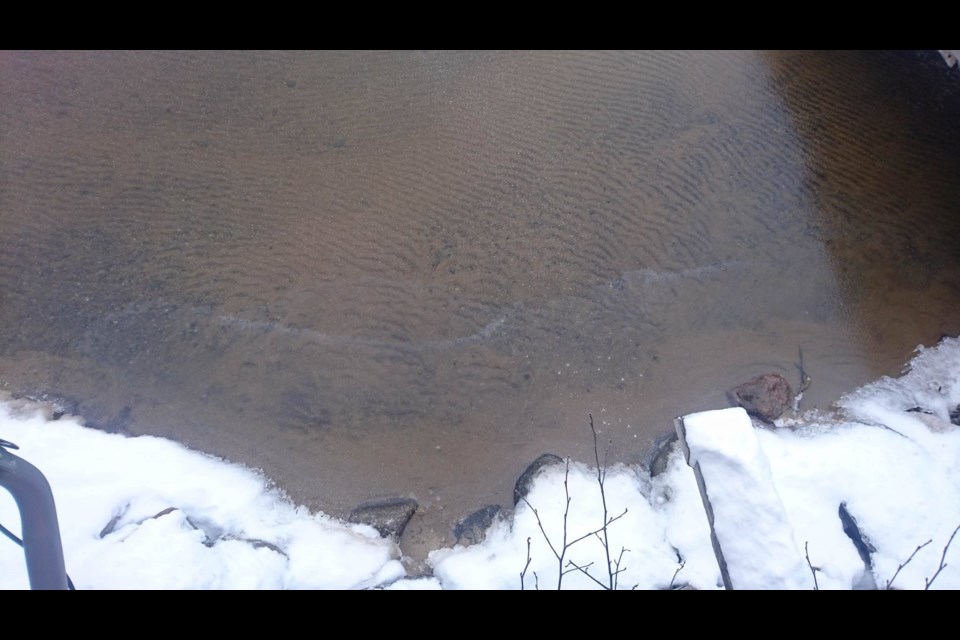Residents of Gogama and Mattagami First Nations are concerned about what appears to be an oil slick found in the Kenogamissi Lake on November 15, 2016 and the earlier discovery of several dead fish in Mattagami Lake on August 31, 2016.
The source of the oil slick photographed on Kenogamissi is not conclusively known. However, local outdoors man David Reid is concerned it is related to the Gogama CN derailment and oil spill, which occurred approximately 30 kilometres to the south of location of the current oil slick on March 7, 2015.
An earlier CN derailment occurred further to the west of Gogama on February 14, 2015.
The photographs of the dead fish accompanying the story were taken in late August by Betty Naveau. The first two were taken near Togo and Twin J Hideaway on Mattagami Lake on August 31, 2016 and the next 3 were taken November 15, 2016 about 18 km north of Mattagami First Nation.
Photographs taken by Clint Chartrand show a defined stretch of water that is said to be an oil slick on Kenogamissi Lake.
“Yesterday I received some more pictures taken on Kenogamissi Sea (Lake),” said Reid. “This is down river from the spill site.”
“So the oil has gone through the High Falls Dam through the walleye spawning grounds and is now heading towards the Mattagami River that flows through Timmins,” said Reid.
The Kenogamissi Lake feeds into the Mattagami River which flows north through Timmins about 50 km to the north on its way to James Bay.
Although the Gogama oil spill can be one source for the oily sheen, there are a number of other possibilities from localized sources such as fuel spills.
“We are concerned about the impact of the oil spill at the Makami River near Gogama,” said Jennifer Constant, a Councillor with the Mattagami First Nation. “We are so dependent on water that we are concerned about what occurred with the derailment into the Makami River and its impact downstream.”
Constant said Mattagami First Nation’s immediate concern when the derailment occurred was over the impact of on the air quality from fumes escaping from the fire from damaged and ruptured rail tanker cars.
The long term concern however is for the quality of the water in the Makami River and the watershed and its impact on fish and wildlife in the area according to Constant.
“We wanted to know how CN would prevent the water from flowing downstream to Mattagami, how the booms would be set up to prevent migration of the oil,” she added.
CN officials have maintained that they responded quickly to contain the oil spill from the derailment, which occurred during the winter, with ice covering the Makami River, which helped keep the oil from immediately entering the waterway.
CN also established a system of booms to prevent the migration of the oil and a three stage water filtering process to remove oil from the water before returning it to the river.
But pressure from the community forced CN to do additional water testing and three of approximately 26 showed elevated traces of oil above Ministry of Environment and Climate Change water quality guidelines.
Jim Heeny, CN spokesperson, has previously said that the company is committed to ensuring the environment is protected and will do whatever science indicates should be done to remediate the impacts of the oil spill.
“Nothing done to remediate the damage to the Makami River will ever be good enough,” said Constant. “But it would help if CN removed the contaminated sediments and solids covered with oil from the water.”
According to Constant, the people of Gogama and Mattagami First Nation have done a great job advocating for the completion of the remedial work by CN and keeping the issue alive so it doesn’t go away and out of sight.
She said that the visit of David Suzuki helped expanded awareness of what is happening because he is a renowned environmental scientist and his visit brought credibility to the issue.
“I am not an expert in hydrology or the movement of contaminants in the water,” acknowledged Constant. “But if there is a massive oil spill into the Makami River near Gogama, common sense tells you it will flow north with the current of the water.”
“It is fair to assume the oil is flowing north,” continued Constant, “and what was seen in the November 15 photographs originated from the Gogama derailment spill.”
TimminsToday phoned the Spills Action Centre of Ontario, the agency that monitors spills on a 24-7 basis to find out if they could explain the appearance of the oil slick.
The staff person who answered the call said for the oil to be proven to be from the Gogama spill there would have to be a continuous plume established from the Gogama site on the Makami River to the Kenogamissi Lake.
Failing that, it is more likely, if it is an oil slick, that it may have originated from a localized source. The staff person also said, during the fall, decaying plant matter in the water also may produce a liquid film that resembles oil sheen or slick; but he would have to look into the situation more thoroughly before drawing any conclusions.
He then asked that TimminsToday provide questions for further answers and that a MOECC media relations representative would respond with answers.



